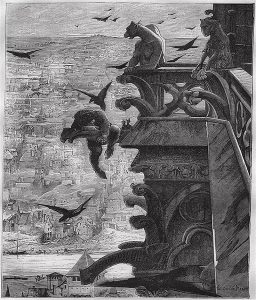
Victor Hugo's 1831 novel The Hunchback of Notre Dame saved Notre Dame cathedral during a crucial period in French history. This is no exaggeration.
In the early nineteenth-century, the historical and cultural value of surviving medieval architecture was ignored by the general populace. Efforts to update the Notre Dame cathedral, which included replacing its stained glass windows with clear glass, disgusted writer Victor Hugo. Hugo was fascinated by the cathedral, visiting it many times in the late 1820s. He struck up a friendship with a priest who explained to him the symbolism inherent in many of the building's architectural details and statues. Enamored, Hugo hoped to preserve the cathedral from any further meddling through his next novel project.
When crafting The Hunchback of Notre-Dame, Hugo took stylistic inspiration from the Scottish writer Sir Walter Scott, the most popular novelist of the day and a pioneer of the historical fiction genre with works like Ivanhoe. Like Scott, Hugo did not just use the past as window dressing: he was interested in recreating a long-departed time and place down to the smallest detail. The story is set in fifteenth-century Paris, complete with its widespread superstitions, rigid social hierarchy, and of course, its gothic architecture.
While one might expect a book born of the desire to preserve historical architecture to be at best a dry read, the continued popularity of the story proves otherwise. Hugo's novel remains a deeply affecting tragedy, powerful in its depiction of humanity's tendency towards both cruelty and compassion. The hunchbacked bell-ringer Quasimodo remains the most popular character of the book, even though he is technically not the protagonist. The original French title of Hugo's book is Notre-Dame de Paris, emphasizing the cathedral over any one character. Regardless, Quasimodo's outcast status and strong capacity for tenderness have endeared him to two centuries' worth of audiences.
Modern readers likely have greater familiarity with the numerous adaptations of the story than they do with the original text. After the novel's publication, Hugo oversaw an operatic adaptation entitled La Esmeralda. A silent film version with Lon Chaney Sr. was one of the hottest films at the box office in 1923, as was a 1939 sound version with Charles Laughton. A great many 90s kids were first introduced to the story through the 1996 Disney animated version, which was later converted into a popular stage musical. While a great many variations of Hunchback are fantastic in their own right, they often strip out the tragic grandeur of Hugo's original. As great as some of the adaptations are, there is no replacement for reading the book.
Victor Hugo's 1831 novel "The Hunchback of Notre Dame" is an epic tragedy about humanity's capacity for cruelty and compassion, as well as a brilliant recreation of medieval Paris. It has been translated into multiple languages and adapted into movies, operas, and musicals over nearly two centuries.


Add a comment to: Spotlight: “The Hunchback of Notre-Dame” by Victor Hugo